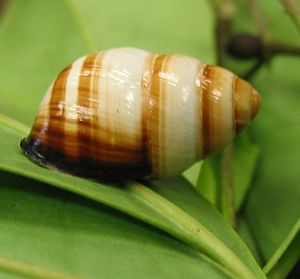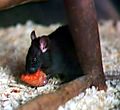Oʻahu tree snail facts for kids
Quick facts for kids Oʻahu tree snail |
|
|---|---|
 |
|
| Achatinella bulimoides | |
| Scientific classification |
|
| Kingdom: | Animalia |
| Phylum: | Mollusca |
| Class: | Gastropoda |
| Subclass: | Heterobranchia |
| Clade: | Euthyneura |
| Order: | Panpulmonata |
| Clade: | Eupulmonata |
| Clade: | Stylommatophora |
| Family: | Achatinellidae |
| Subfamily: | Achatinellinae |
| Genus: | Achatinella Swainson, 1828 |
| Diversity | |
| 41 species, 9 extant species remained in 2014 | |
Oʻahu tree snails are a group of colorful, tree-living snails found only in Hawaii. They belong to the genus Achatinella. These snails breathe air and live on land, making them a special type of land snail.
Sadly, all the species of Oʻahu tree snails that are still alive today are endangered. This means they are at risk of disappearing forever. Long ago, these snails were very common in Hawaii. They were even mentioned in Hawaiian stories and songs. People also used their beautiful shells to make lei (flower necklaces) and other decorations.
Many of these tree snails have a unique feature: their shells spiral to the left! This is called sinistral or left-handed coiling. Most snail shells spiral to the right.
Contents
Where Do Oʻahu Tree Snails Live?
There are 41 known species of Oʻahu tree snails. All of them are found only on the Hawaiian island of Oʻahu. This means they are endemic to Oʻahu, which means they naturally live nowhere else in the world.
Out of the original 41 species, only 13 are still surviving today. Some of these species have very few individuals left, sometimes less than 50. Others have a few hundred, but their numbers are still very low.
Why Are Oʻahu Tree Snails Endangered?
All 41 species of Oʻahu tree snails are listed as endangered by the United States government. The IUCN, a global organization, lists many of these species as extinct (meaning they have completely died out). The rest are listed as critically endangered, which is the highest risk category before extinction.
The biggest reason for their decline used to be people collecting too many of them. But now, other threats are causing problems. These include invasive species (animals brought to Hawaii that don't belong there). These invaders include rats, Jackson's chameleons, and a very hungry snail called Euglandina rosea. These animals hunt and eat the native Oʻahu tree snails, causing their numbers to drop quickly.
What Do Their Shells Look Like?
Oʻahu tree snails have shells that come in many different patterns, colors, and shapes. They are usually about 0.75 inches (1.9 cm) long. Most of their shells are smooth and shiny. They can be oblong (oval-shaped) or ovate (egg-shaped). You can find them in a rainbow of colors, including yellow, orange, red, brown, green, gray, black, and white.
Scientists group these snails into three main types, called subgenera, based on their shell features.
How Do Oʻahu Tree Snails Live?
Habitat
These snails live in trees. You can find them in the mountains of Hawaii, in both dry and moist forests and shrublands. They usually live at elevations above 1,300 feet (400 meters). Most Oʻahu tree snails spend their whole lives on just one tree!
Feeding Habits
Oʻahu tree snails are nocturnal, meaning they are active at night. They eat by grazing on tiny fungus that grows on the surface of native plant leaves.
Sometimes, these snails are found on plants that are not native to Hawaii. However, scientists are not sure if the fungus on these non-native plants can provide enough food for the snails to stay healthy and have babies.
In special care, like in a lab, these snails can eat fungus that grows on Metrosideros polymorpha leaves. They can also eat cornstarch mixed with water or a type of fungus called sooty mold grown in a lab. To get enough calcium for their shells, they are given cuttlebone.
Life Cycle
Adult Oʻahu tree snails are hermaphroditic. This means each snail has both male and female reproductive parts. They can live for many years. Unlike many snails that lay eggs, these snails give birth to live baby snails.
Threats to Their Survival
Oʻahu tree snails grow very slowly and don't have many babies. This makes them very sensitive to any loss of individuals. This can happen if people collect them, if predators eat them, or if their environment is disturbed.
The biggest dangers to Oʻahu tree snails today are:
- Predation by other snails: An introduced snail called Euglandina rosea is a major threat because it hunts and eats Oʻahu tree snails.
- Predation by rats: Different types of rats, like the Polynesian rat, Norway rat, and Black rat, also eat these snails.
- Habitat loss: Non-native plants are spreading into the higher elevation forests where these snails live, destroying their natural homes.
- Jackson's chameleon: The Jackson's chameleon, which was brought to Hawaii in the 1970s, also eats Achatinella snails.
- Land planarian: A type of flatworm called Platydemus manokwari is another predator of these snails.
Here are some of the animals that prey on Achatinella snails:
Oʻahu Tree Snails in Hawaiian Folklore
In ancient Hawaiian stories, the Kāhuli snails, which are Oʻahu tree snails, were known as pūpū kani oe. This means "shell that sounds long" or the "singing shell." People believed these snails could sing at night. Experts think this idea came from the chirping of crickets, which are active at night when the snails are also out.
Native Hawaiians used the shells of these snails to create beautiful kahuli shell lei. In the 1800s, these shells became very popular souvenirs. This popularity might have contributed to the snails' decline. King Kamehameha III even named his summer palace Kaniakapupu, which means "the singing of the land shells," because so many snails lived in that area during his time.
Images for kids
See also
 In Spanish: Achatinella para niños
In Spanish: Achatinella para niños






